

![]()
![]()
This Page:
Tina Blau
Minna Budinsky
Marie Egner
Marianne Eschenburg
Camilla Friedländer
Hedwig Friedlander
Ernestine von Kirchsberg
Broncia Koller-Pinell
![]()
![]()
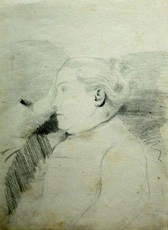
Self-portrait--
representative work.
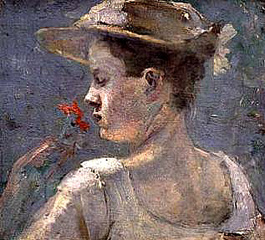
Nuori nainen 1880--
representative work.
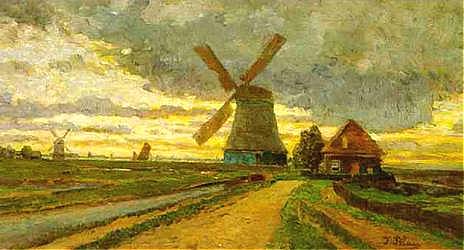
Abend in Volandam [Evening in Volandam]--representative work.

Pappel Allee vor einem Dorf--
representative work.
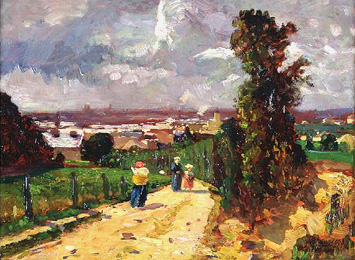
View of Vienna--
representative work.

St. Veit near Vienna--This may or may not be
Yard in St. Veit near Vienna which was exhibited
in Fine Arts Palace, 1893 Exposition.

Autumn in
the Prater, Vienna--
It is unclear if this is the Autumn exhibited
in Fine Arts Palace, 1893 Exposition.
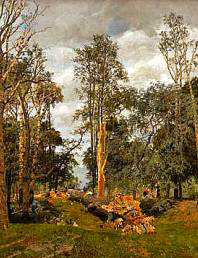
Fallen Giant
1882--
exhibited in Fine Arts
Palace, 1893 Exposition.
Encouraged by her physician father, Tina Blau, born in Vienna, studied art privately with the Hungarian artist Antal Hanély, with the Viennese landscape painter August Schäffer, and at the drawing school of Joseph Aigner, followed by studies in Munich with Wilhelm Lindenschmitt. A co-founder of the Viennese Art School for Women and Girls, she taught landscape painting for twenty years. Blau is considered one of the most important Austrian painters of the second half of the nineteenth century, but two of her paintings (Autumn and Yard in St. Veit) were included in the German exhibit at the 1893 Exposition. She married Heinrich Lang, a painter of battle scenes.
![]()
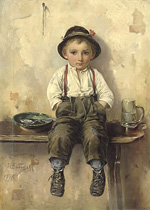
Tyroler Bauernbub--representative work
Song of Love (image unavailable)--exhibited in
Rotunda, Woman's Building, 1893 Exposition
Minna Budinsky was an Austrian artist who received her training at the School of Applied Arts from 1973 to 1977. She exhibited in Austria and internationally. No other information in English is available online.
![]()
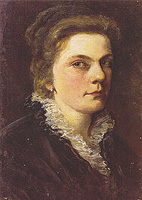
Self-portrait (1878)--representative work

In der
Blutenlaube--
representative work.
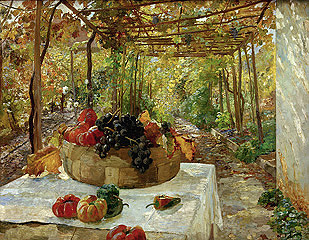
In der Pergola c. 1910--
representative work.
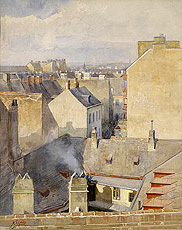
Blick aus dem Atelier Klagbaumgasse Wien
c. 1890--representative work
Chickens (image unavailable)--exhibited in the
Rotunda, Woman's Building, 1893 Exposition.
Marie Egner studied art first with Hermann von Königbrunn, later with Carl Jungheim at the Academy of Düsseldorf, and finally with Emil-Jakoo Schindler where Olga Wisinger also was enrolled. For several years, they all stayed summers at Schindler's Schloss Plankenberg (sort of a 19th Century version of a McDowell Colony for artists). Egner traveled and exhibited often and at one period in her life was in charge of a painting school in England.
![]()
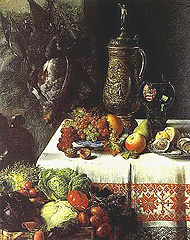
Hunting Still Life--
representative work.
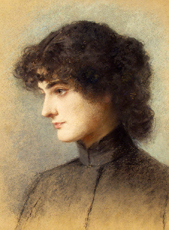
Frauen Portrait Sezession
1900--representative.
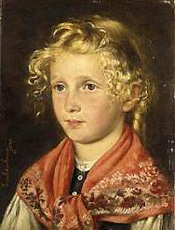
Portrait of Young
Girl 1887
--representative work.

Italian Woman--
representative work.
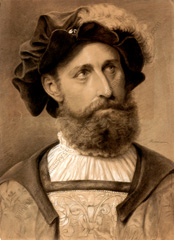
Portrait of Man in
Renaissance Costume--
representative work.
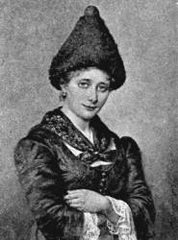
A
Sellrein Woman--
exhibited in Woman's
Building, 1893 Exposition.
A Tyrolean Girl (image unavailable)--exhibited in
Rotundra, Woman's Building, 1893 Exposition.
Baroness Marianne von Eschenburg was an Austrian painter who studied art with her uncle Carl von Blaas and, in Paris, with Carolus Duran, Henri Martin, and Elise Koch. She is particularly known for her portraits. Her husband's name was Purtscher. No other information is available online.
![]()
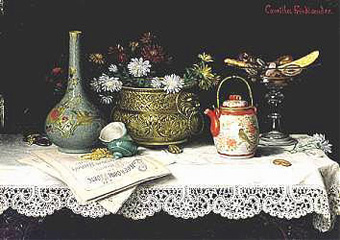
Still-leben--representative work.

Still-leben mit Muschel--representative work.

Autumn Still life with plums,
apples and wine glass
--representative work.
Still Life (image unavailable)--exhibited in
Fine Arts Palace, 1893 Exposition.
Still life painter Camilla Friedländer was born in Vienna and studied art under her father, Friedrich Friedländer, a painter of military subjects and portraits. In 1901 Friedlander became a nun, entering the Salesian Monastery. No other information is available online.
![]()
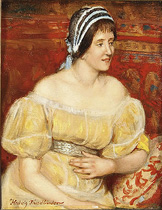
Woman in
a Yellow Dress
--representative work.

Interior Scene of Mother
Bathing her Children
--representative work.
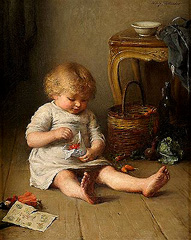
Child--may or may not be
the Child exhibited in
Rotunda, Woman's Building,
1893 Exposition.
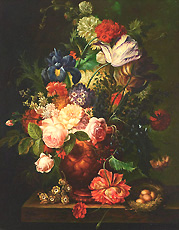
Floral Still Life
--representative work.
Hedwig Friedlander was an Austrian artist who studied under Norwegian painter Carl Frithjof Smith in Munich and at the School of Applied Arts in Vienna in Laufberger. No other information is available online.
![]()
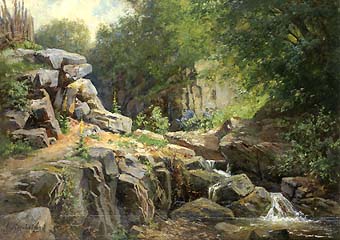
Waldbach im Sonnenschein
1899--representative work.
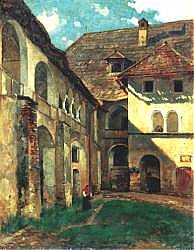
Muhlviertler Hof--
representative work.
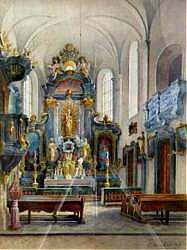
[title unknown]--
representative work.
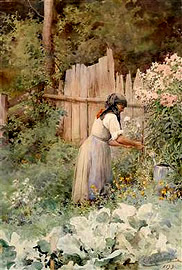
Peasant Woman in a Vegetable Garden
1899--representative work.
Farm House in Lower Austria--exhibited in Rotunda,
Woman's Building, 1893 Exposition.
Born in Verona, Ernestine von Kirchsberg studied art at the Zeichenakademie in Graz under Hermann von Königsbrunn and at the Wiener Akademie with Eduard Peithner von Lichtenfels, August Schäffer, and Hugo Darnaut. She was known for her landscapes and won a medal at the 1893 Exposition.
![]()
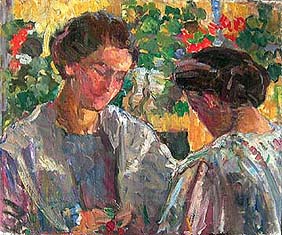
Sisters Broncia and Etka
--representative work.

Kinder Portrait Im Bettchen
--representative work.

Still Life with Parrot--representative work.
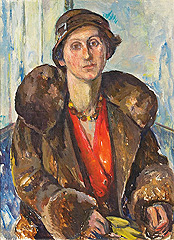
Damenportrat--representative work.
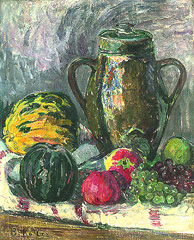
Still Life--representative work.
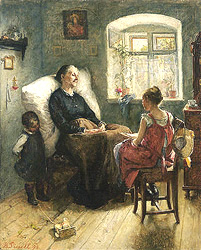
Nachmittag bei der Grossmutter
--This may or may not be
At Grandmother's which was
exhibited in the Rotunda,
Woman's Building, 1893 Exposition.
The records for the Women's Building identify this artist as "Baroness Pinell," but no record of such a "baroness" is available online. However, there was a famous Jewish-Austrian female artist at the turn-of-the-century named Broncia Koller-Pinell (born Bronislava Pineles in Sanok, Poland) who began exhibiting in 1888, but who is not mentioned by any of those names in the records of the Chicago World's Fair. Perhaps bad handwriting accounts for the substitution of "baroness" for "Broncia" (several other badly mis-spelled names are found in the fair's records). If so, her painting style changed drastically from the conventional 19th century "grandmother" painting above, which was presumably exhibited in the Women's Building, to the very modern and experimental styles she became known for a few years later and for the rest of her career. (See the differences in the paintings above.) Assuming the correct artist has been identified here, Broncia's family moved to Vienna when she was thirteen and changed their family name to Pinell. Her earliest studies in drawing were from the sculptor Raab, later with Alois Delug and in Munich at Ludwig Herterich's private drawing school. After her marriage to entrepreneur Hugo Koller, an art patron, and the births of two children, she became involved with the Wiener Werkstatte (Vienna Workshops) and Secession circles, especially with Gustave Klimt's group with whom she often exhibited. She had a very successful career.
![]()
![]()
Go to Austrian Women Painters, p. 2
Return to Women Painters Index
Return to Site Index
![]()
![]()
Text written by K. L. Nichols
Painting, top of page: Marie Konstantinovna
Bashkirtseff,
In the Studio (1881).
Return to Nichols Home Page
Suggestions/Comments: knichols11@cox.net
Posted: 6-25-02; Updated: 5-08-20